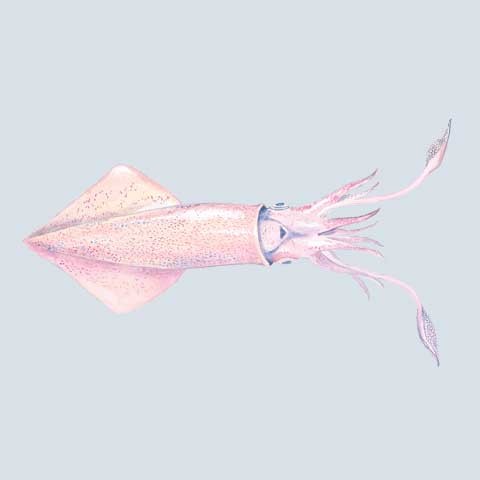More than half of all squid landings in the Northeast come from Rhode Island. But last year, as a result of the pandemic, some Rhode Island fleets saw earnings dip by 30 percent.
Jason Didden, a fishery management specialist at the Mid-Atlantic Fishery Management Council, says that so far in 2021, total longfin landing are off to a slow start at less than 5 million pounds landed, compared to this time last year when around 11 million pounds had been landed. Illex season typically gets started in May and 2021 squid quotas are the same as 2020: 23,400 metric tons for longfin and 30,000 metric tons for illex. (The illex quota was expected to be reviewed in May.)
Coming off a troubling year has taken great effort. Kat Smith, Director of marketing and communications at Town Dock, a large processor distributor based in Narragansett, R.I., says “at this point, things are still not back to normal — although we’re glad that the light at the end of the tunnel gets closer every day. There continues to be a global shipping container shortage, covid-related disruptions, and now, the Suez Canal issue, all of which have supply chain impacts for seafood and many other industries.”
Two Town Dock products, says Smith, Rhode Island calamari (longfin inshore squid) and premium domestic calamari (northern shortfin squid), which are both caught in Rhode Island and are Marine Stewardship Council certified sustainable, are always popular.
“When we look at our foodservice offerings, we are certainly better than this time last year — restaurants are ramping up with states’ reopening plans, and more people are vaccinated and excited to go out to eat. Calamari — and seafood, in general — has also enjoyed year-over-year growth in retail and grocery stores. The demand is very good; once the supply chain has sorted itself out, we are excited for the opportunities ahead.”
In 2020, landings had been trending strong until the covid-19 pandemic hit. But longfin landings were ultimately impacted by the pandemic and depressed restaurant demand. In total, 9,392 metric tons — about 41 percent of annual quota, valued at $25.6 million was landed in 2020, says Didden. In 2020 longfin was priced around $1.24 a pound, down by about 21 percent from the previous year.
While illex prices were down about 17 percent in 2020, or about $0.39 a pound, it was another strong year overall, says Didden — with 28,135 metric tons valued at $24.3 million landed.
A potential concern for some within the industry is offshore wind development, and the impacts on the feeding behaviors of longfin squid. The pandemic has also highlighted how squid and other industries are part of complex global supply chains.
“Most of our squid catch is shipped out to China and other locations, processed, frozen, and then sent on to final consumer markets, including some of it coming back to the United States,” says Diane Lynch, chairwoman of the Rhode Island Food Policy Council. “Over the past decade, consumer demand for local food has risen steadily, driven by many different factors but most notably by the consumer preferences of millennials. As part of this, consumer demand for locally caught, locally processed, locally consumed fish has been steadily growing in Rhode Island and around the U.S.”
Boosting infrastructure and removing barriers to processing — like adding more targeted wastewater processing capacity — have potential to increase jobs and local processing, adds Lynch.
“We have several long-standing, high quality squid processors in the state who would all consider increasing their local processing capacity if obstacles were removed. We also have many smaller, start-up processors who might be interested in increasing their operations as well, not just for squid, but for a broad range of locally caught finfish.”
Overall, there is a sense of optimism within the industry. “We were fortunate to get through last year as well as we did, and as things open up we know people are going to be thrilled to go to their favorite restaurants and enjoy their favorite appetizer — calamari!” says Smith. “The demand is strong and growing, and we continue to supply calamari (domestic in particular) to our customers and are optimistic that as soon as the supply chain is untangled, we will have a great year ahead.”







